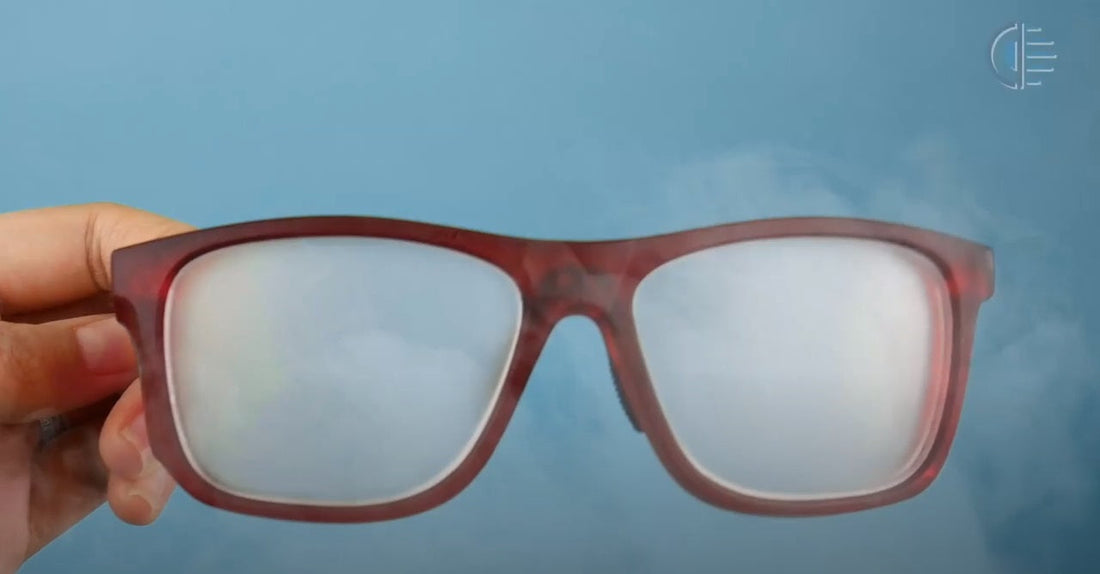In this article we will look at Anti Fog Coatings on Glasses, the Science and the Myths behind it.
We are all aware of the common problem of fogging – sometimes it used to happen to us when we went from rain outside to inside, now it happens every day because we are all wearing face coverings.
Fogging happens when there is a difference in the temperature of the surrounding air and a surface, the outcome of this is that the air condenses on to the surface and gathers on it causing it to fog up. This is because the water molecules become gas as they heat up in the surrounding temperature and when they come into contact with a cooler surface such as the lenses on your glasses condense to form water droplets causing this temporary impairment for us all.
While there is very little that you can do to prevent fogging – it is after all, a matter of physics, you can help to reduce fogging on your glasses.
However with todays modern technology, you can now apply an anti-fog coating to your lenses to help reduce the fogging that takes place. Anti-fog coatings are chemicals that prevent fogging on the surface of your lenses by inhibiting the condensation of water on the surface.
An anti-fog coating works by chemically affecting the adhesion of water molecules, preventing them grouping into larger clusters that can impair vision. If your glasses are frequently exposed to temperature changes or humid conditions, you’ll likely want an anti-fog coating to help combat condensation. The same goes for anyone who engages in strenuous activities such as physical labour, participation in sports, or exercise. Any activity that causes your body temperature to fluctuate will likely lead to lens fogging.
HOW WAS ANTI-FOG DEVELOPED?
Anti Fog Technology was first developed by NASA in the 1960’s as part of the Gemini program. The astronauts frequently experienced fogging on the visors of their helmets during space walks and so this prompted scientists at NASA to develop a solution.
Anti-Fog technology has come a long way from then with a large number of coatings, chemicals and additional technology now being used.
The most popular anti-fog chemicals are called surfactants and they work by minimising the surface tension of the water and so reducing fogging.

REMEMBER…
Any anti fog coating requires UV light to charge it and so fogging will be reduced if you expose your lenses to UV light – this means the anti fog coating will not work well in the dark or in low light conditions.
Anti Fog chemicals do reduce in effectiveness over time, while some anti fog coatings are permanent, it is likely that you will need to have them re-coated in a few years, especially if you are cleaning your lenses a lot.
Myths Behind Anti Fogging…
The internet is littered with myths about fogging and how to prevent it – proving that this simple matter of physics affects all of us in our daily lives.
Some internet sources promote the use of household liquids and chemicals that can be used as an anti fog. These chemicals are known as demisters and are used to prevent fogging on transparent surfaces (think of your window cleaner on your shower), how they are not created for your glasses specifically and so are likely causing more harm than good, let’s take a look at some of them;
Toothpaste – ah yes, everyone loves the smell of fresh minty goodness in their eyes…
Toothpaste has bee known to work as a demister however it is likely to remove any anti fog coatings already applied to your glasses (and any other coatings including your tints, anti scratch and UV blocking). It is abrasive and can be a nightmare to get off. You can also put shampoo, conditioner, shaving cream or soap into this category.
Some people swear by dipping their goggles or glasses into fresh water or the pool to prevent fogging, however this does not work – water does not prevent fogging.
You could spit onto your glasses, but this isn’t very hygienic and will only last a few minutes.
We have also been told about people putting a naked flame against their lenses to prevent fogging – aside from not working at all, this is a costly way to prevent fogging and is likely only to stump you will a bill for a new pair of glasses to replace the old ones you have melted.
Solution?
Well this one is fairly easy – NASA has already done the hard work! Specially developed anti fog coatings are optically thin by nature and are usually hydrophilic helping to maximise surface energy and reduce fogging.
With the addition of your anti-fog your lenses will remain 100% clear!
You can either use a temporary anti fog coating such as Cat Crap Paste or you can add an Anti Fog Coating to your Prescription Safety Glasses.
What situations is anti fog used?
There are a variety of applications where anti fog can come in handy. The coating ar typically applied to glasses, dive masks, goggles, car windscreens any type of visors, kitchen or bathroom windows and shower enclosures. However there are also a range of industrial uses for it including industrial mirrors to improve transmission and reduce glare, UV cured military coatings for lens applications and have also been used for beam splitting, dichroic, dielectric, gold infrared, metallic, transparent conductive, ultraviolet, optical, narrow bandpass uses.

